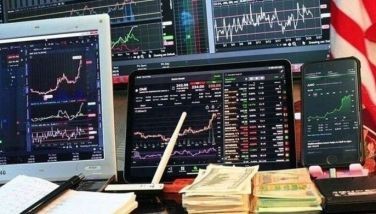The 'IPIS' theory
We held our investors’ forum last Feb. 11 wherein we discussed our outlook for the 2010 and laid out strategies for a highly volatile Year of the Tiger. At the end of the presentation, a Q&A session was conducted. Below are several questions that we believe will be relevant to our readers who were not able to attend.
Q. Can you explain the “IPIS” theory which recently spooked the markets?
A: During the presentation, we mentioned the “IPIS” theory which recently caused a substantial pullback in the market. The theory states that if you see one “ipis (or cockroach)” you are bound to see more coming. This means that the sovereign debt problems that we saw in Dubai and Greece may not be one-off situations. In fact, now we are seeing similar concerns spreading to other European countries like Portugal, Spain, Ireland and others.
Similar to the 1997 Asian Crisis where Thailand was the epicenter that eventually spread to other Asian countries, Greece may now be the epicenter of a possible contagion in Europe.
Q: How do you see the Eurozone problem playing out and how do you see it affecting the local markets?
A: Eventually, the EU will come out with a bailout of Greece, which is crucial. It looks like they are going to support Greece. But the problem with supporting Greece is that Spain, Portugal and other countries are in the same boat and will probably be asking for the same bailout. As we said, we have this “IPIS” theory. We don’t know yet what’s going to come out. In fact, there is also the State of California and the State of New Jersey which have a bigger debt problem. Also there are similar concerns in Eastern Europe, in countries such as Latvia, Ukraine and Kazakhstan.
The bailout can probably cause the market to rally, but the problems will still be around. During our presentation, we showed you what happened in Asia in 1997, because that is what is closest to the 2008 sub-prime problem and now with the European sovereign debt problem. Hopefully, the European governments and the ECB will come out with something that is acceptable to the market.
Q: Your IPIS theory is actually very spooky. What are the chances that this turns to another sub-prime crisis? What are the chances that your S&P 500 index target of 1,250 and PSEi target of 3,300 goes awry?
A: Unlike the sub-prime crisis in the US, the main difference here is that the problems in the Eurozone are problems of sovereign debt. Regarding Greece, we believe that the IMF, the Eurozone, Germany or France may bail it out in one way or another. We are also concerned about California, New Jersey and some other US states, but we know that the US government will bail them out. Thailand, Malaysia, Korea and Indonesia were also bailed out by their governments and the IMF in the late-1990s..
Regarding the targets, our basic thesis is that the bull market is intact. What we are experiencing is a correction. People are talking about a “double dip” or a depression coming back in. But given this possibility, we know that the governments are being alert and are very aware of what can happen if they make mistakes.
We are quite fortunate that we have Bernanke, who is the expert on depressions. In addition, policymakers now know what happened in the 1930s when the US had the Great Depression. They are also aware of what Japan did during its lost decade. So they are aware of these problems. In our columns in the past, we have said that with the government at your back and with your Big Brother with you, we would rather be on their side and not against them.
Of course, as a result of this current correction, the targets of 1,250 for the S&P 500 index and 3,300 for the PSEi may be delayed. But today, we see 2,800 (in the PSEi) actually holding. We will see a rally but we don’t think we will breakout to higher levels right away. The market probably needs more consolidation at these levels. But our targets of 1,250 for the S&P 500 and 3,300 for the PSEi remain intact.
Q: What is your forecast for the peso-dollar rate for 2010?
A: We are looking closely at the Euro which is weakening because of their debt problems. Generally, the dollar looks like it is going to strengthen. For those of you who believe in technical analysis, you may note that the dollar chart has broken out of its long-term downtrend, which means it will probably go higher to the detriment of other currencies.
With the US showing (economic) growth and the Euro having problems, the dollar would probably continue to improve. This means that the peso would probably weaken towards the 48 level within the year, not because of a problem we have, but mainly because of the strength of the dollar against other currencies. But as we all know, the peso performance is cyclical. By the time November/December comes, with all the remittance coming back in, we will probably see the peso again improving back to the 45 to 46 levels.
As we said during the presentation, we showed you that the peso has been one of the most stable currencies during the past year. In fact in January, the peso broke the 46 level. If the central bank did not intervene at the 45 level, it would have broken even that level.
We expect the BSP to defend the peso if it depreciates to around 48 to 49. They will also be there to intervene if the peso strengthens too much to 45, just like they did before. We believe that the BSP peso-dollar rate forecast of 45 to 49 for the year will hold.
Q: How do fund managers strategize their diversification during market downturns?
A: During corrections, we look for a more defensive portfolio. We tend to sell higher beta issues (which drop more than the index during downturns). After lightening up, we reallocate some of the funds to more defensive issues, e.g. high dividend-paying stocks which in a downturn do not decline as much.
Q: As an investor, should we change our strategy individually if we are already earning 20 to 30 percent? Should we sell out and wait for the next dip to come in?
A: The biggest money is made on long-term investments and not on short-term investments.
We always advise clients or investors who like trading to “trade in 3s.” For example, if you have 1,000 shares of PLDT and goes up to a certain level, you sell a part of it (probably 10 percent to 30 percent of your position). If it goes down, you buy it back. You have a core holding of that position and you take advantage of the swings so that you don’t have to sell everything. In that way, you are actually familiarizing yourself with the movement of that issue.
Furthermore, when you buy a stock, you look at it as a business. Look for companies that are no. 1 in their field, or those that if you were to go into business, you would like to be in that company.
For example Visa. You know that there is a secular change from paper money into plastic. You know that people are going to change their way of spending from cash to plastic. This is a world-wide phenomenon. They are the no. 1 credit card issuer. They have no credit risk. And you know that you would like to go into that business where people are using your product and everyday you are earning.
So invest in a company with a business that you believe in. Hold a core position in that company. If you feel that the price has gone up a lot, and probably the market is going to correct, you sell part of that position. When it goes down, you buy it back. But more importantly, instead of selling out a winner, you are able to hold on to your core position and avoid the mistake of shifting your investment to a losing company with weaker fundamentals.
Q: When is the best time to invest in stocks or mutual funds?
A: Tonight! You have to be invested the market. Do not trouble yourself in “timing the market.” Remember, it is not “timing the market” but the “time you spend in the market” that ultimately makes you the big money.
Have a long-term investment horizon and stick with your optimal asset allocation. If you are underweight in stocks or do not have any position at all, buy Philequity Fund or Philequity PSE Index Fund using the cost-averaging method or buying on a staggered basis. But if you are overweight stocks, reallocate by switching into our Philequity Bond fund or Philequity Dollar-Income fund.
For comments and inquiries, you can email us at [email protected]. You can also view our archived articles at www.philequity.net or www.wealthsec.com.
- Latest
- Trending































